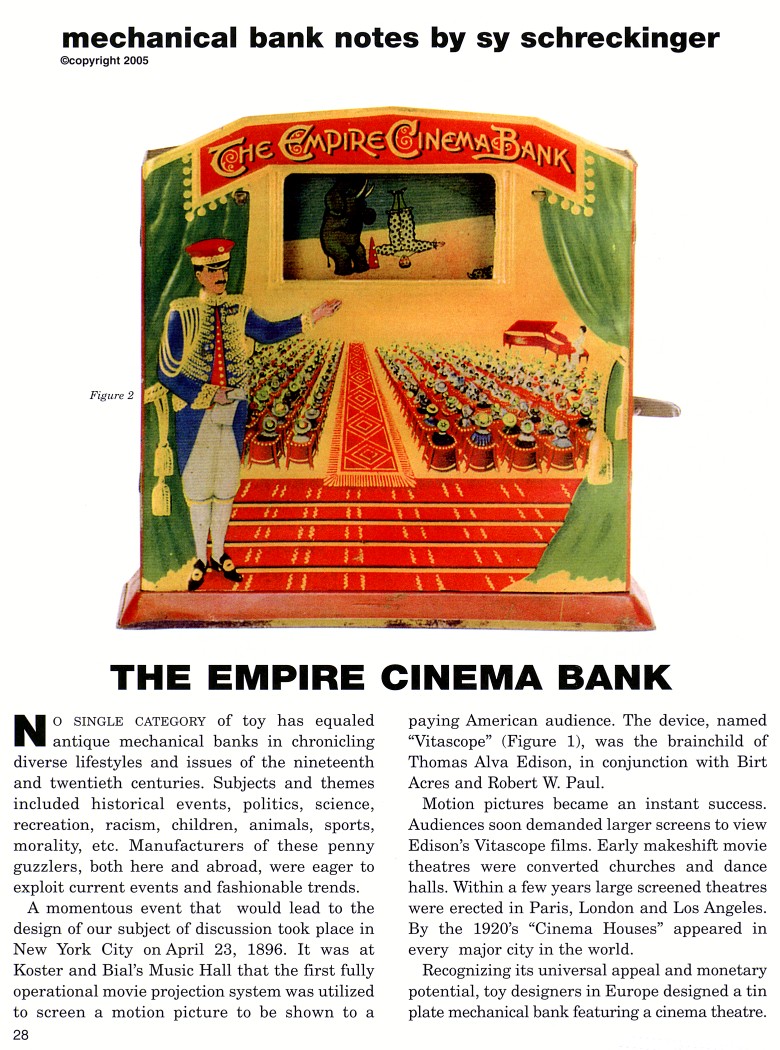|
The Empire Cinema Bank
by Sy Schreckinger – ANTIQUE TOY WORLD Magazine – July, 2005
No single category of toy has equaled antique
mechanical banks in chronicling diverse lifestyles and issues of the
nineteenth and twentieth centuries. Subjects and themes included
historical events, politics, science, recreation, racism, children,
animals, sports, morality, etc. Manufacturers of these penny guzzlers,
both here and abroad, were eager to exploit current events and fashionable
trends.
A momentous event that would lead to the design of our subject of
discussion took place in New York City on April 23, 1896. It was at Koster
and Bial's Music Hall that the first fully operational movie projection
system was utilized to screen a motion picture to be shown to a paying
American audience. The device, named "Vitascope" (Figure 1), was the
brainchild of Thomas Alva Edison, in conjunction with Birt Acres and
Robert W. Paul.
Motion pictures became an instant success. Audiences soon demanded
larger screens to view Edison's Vitascope films. Early makeshift movie
theatres were converted churches and dance halls. Within a few years large
screened theatres were erected in Paris, London and Los Angeles. By the
1920's "Cinema Houses" appeared in every major city in the world.
Recognizing its universal appeal and monetary potential, toy
designers in Europe designed a tin plate mechanical bank featuring a
cinema theatre. Their creation was entitled "The Empire Cinema Bank"
(Figure 2).
To date, since neither catalog nor patent information has surfaced,
the bank's manufacturer and/or designers remain unknown. However, some
information has been obtained from a circa 1913 catalog of the James
Wisbey Wholesale Toy Company of Houndsditch, England. In it is a page
featuring an illustration of "The Empire Cinema Bank" (Figure 3)
accompanied by a brief description of its action and pricing details:
"Number 5000e. New Line in Savings Bank. A picture appears each time a
coin is inserted. 4 shillings and 6 pence a dozen."
In addition to "The Empire Cinema Bank" two other tin lithographed
mechanicals were pictured and offered for sale in the Wisbey catalog.
These were "Royal Trick Elephant" and "Monkey and Tray". It may, perhaps,
be presumed that the same thus far unidentified company produced all three
banks and that Germany was the country of origin.
Pertinent information relating to "The Empire Cinema Bank" has been
offered by European mechanical bank historian, John Haley. Mr Haley's
research leads him to believe this mechanical was modeled after the famous
Empire Cinema Theatre in Leicester Square in London. The theatre was
established in 1896 and was the first to present animated films in
England. Initially, it was known as the Empire Music Hall. The name was
later changed to the Empire Theatre and then finally to the Empire Cinema.
It seated eight hundred patrons, and was the model for other movie
theatres throughout England. Many of these theatres adopted the name
"Empire Cinema".
Operation of the "Empire Cinema Bank" is
imaginative and appropriate
to the subject. Prior to coin insertion, the theatre screen is hidden by a
tin plate split cover displaying the words "WATCH THE NEXT PICTURE",
(Figure 4). Each time a coin is inserted and the protruding lever is
depressed, the curtain, seen in Figure 4, opens to expose various pictures
of animals and clowns in acrobatic positions. Coins are deposited
automatically as the lever is pressed downward, and retrieved via a
square, key lock, trap door coin retainer located underneath the base.
"The Empire Cinema Bank" is extremely rare, with only one, possibly
two, examples known to exist in collections. Its scarcity may not only be
attributed to fragile and complicated construction (as are all tin plate
mechanicals), but also to timing. The bank was advertised in the Wisbey
catalog just a few months prior to the declaration of World War I, a
period when all German imports to England were terminated.
To my knowledge, "The Empire Cinema Bank" has never been reproduced.
Despite its tinplate construction and diminutive size, i.e., Height: 5-1/2
inches, Width 5-5/8 inches, it is an attractive example of the early days
of cinema and a most valuable addition to a mechanical bank collection.
Acknowledgements: The superb example of "The Empire Cinema Bank",
Figure 2, is in the collection of Max Berry.
My special thanks to John Haley for providing the Wisbey catalog page
featured in Figure 1, and his research relating to the Empire Cinema
Theatre in London.
|


